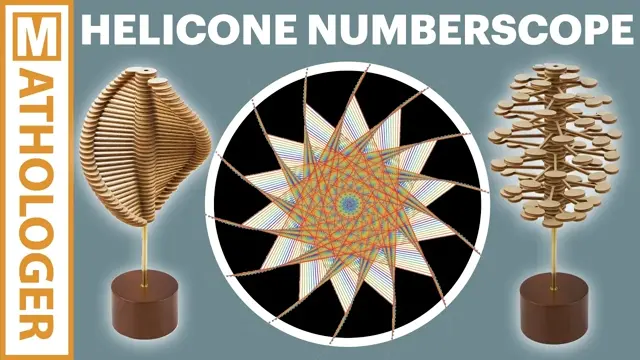2025-01-06
[public] 20.0K views, 3.02K likes, dislikes audio only
This is a corrected version of a video that I uploaded two days ago. After a critical mistake was discovered in the "Nature's Numbers" part of the video, I decided to scrap the original video, fix the errors and republish the video (many more hours down the drain :( Anyway, had to be done. Just in case you are wondering my list of best approximations of pi did not fit in with my definition. This was first pointed out by @typha
I've collected the comments on the original video in this pdf file
https://www.qedcat.com/phyl/comments_collection.pdf
If you've got access to Mathematica, you can download my Helicone lab here: https://www.qedcat.com/phyl/helicone.nb
0:00 Intro
2:48 Helicone lab!
9:41 Fibonacci Christmas tree
12:28 Number scope
17:22 Nuts and bolts
23:41 Fractional angles
27:34 3, 22/7, ...
34:07 Nature’s numbers
41:45 Best Fibonacci fractions
43:36 Original Helicone Puzzle
45:55 Microscope zooming spectacle
47:05 Thanks!!
John Edmarks website with sections dedicated to his helicone and presentations by him about his work:
http://www.johnedmark.com/#/rotating/
http://www.johnedmark.com/talks
If you want to buy one of these helicones google both "helicone" and "lollipopter".
Christian Merighi's online app (needs WebGPU). Quite wonderful, really. On my mac it works best in using the Edge browser.
https://js.pacem.it/3d/helicone
The earlier Mathologer videos about the golden ratio and the Fibonacci numbers in nature referred to in this video:
The fabulous Fibonacci flower formula /youtube/video/_GkxCIW46to
Infinite fractions and the most irrational number /youtube/video/CaasbfdJdJg
Here is a bare bones version of the microscope: https://demonstrations.wolfram.com/PhyllotaxisExplained/
The technical term for Wolfram's spikey is Rhombic Hexecontahedron.
There is also a plant called Heliconia. However it looks nothing like the Helicone :)
Idea for the real-life Fibonacci Christmas tree: individually addressable LEDs. See, for example, this intro https://www.youtube.com/watch?v=LOimwthcdqo&feature=youtu.be
The Moravian star has its own Wiki page. Worth checking out. https://en.wikipedia.org/wiki/Moravian_star
Mathologer junior is my son Karl and the Mathologer "junioress" behind the camera is my daughter Lara. Thanks Lara and Karl! And in this video we are paying a visit to my office at Monash University in Melbourne, Australia.
In Chinese mathematics, the fractions 22/7 and 355/113 are known as yuēlǜ (约率; 'approximate ratio') and mìlǜ (密率; 'close ratio').
22/7 was found by Archimedes in the second century as part of the strict inequality 223/71 less than pi less than 22/7 and 377/120 was mentioned by Ptolemy in the 3rd century. Also, note that both 223/71 and 377/120 are detected by our number microscope (but not by the usual continued fraction approach).
Relevant encyclopedia of integer sequences entries:
Music: Christmas tree by Zac Nelson, Tea time by Ty Simon and I promise by Ian Post,
T-shirt: Pretty sure it's this one https://www.etsy.com/listing/720022200/pi-christmas-math-science-algebra-gift
Enjoy!
Burkard
/youtube/video/_YjNEfZ0VqU?t=168
/youtube/video/_YjNEfZ0VqU?t=581
/youtube/video/_YjNEfZ0VqU?t=748
/youtube/video/_YjNEfZ0VqU?t=1042
/youtube/video/_YjNEfZ0VqU?t=1421
/youtube/video/_YjNEfZ0VqU?t=1654
/youtube/video/_YjNEfZ0VqU?t=2047
/youtube/video/_YjNEfZ0VqU?t=2505
/youtube/video/_YjNEfZ0VqU?t=2616
/youtube/video/_YjNEfZ0VqU?t=2755
/youtube/video/_YjNEfZ0VqU?t=2825

